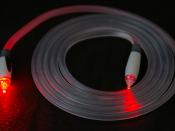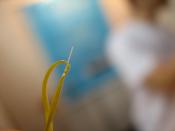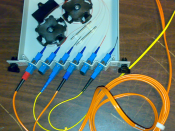Optical Networks
The optical fiber can be used as a medium for telecommunication and networking because it is flexible and can be bundled as cables. Although fibers can be made out of either plastic or glass, the fibers used in long-distance telecommunications applications are always glass, because of the lower optical absorption of glass. The light transmitted through the fiber is confined due to total internal reflection within the material. This is an important property that eliminates signal crosstalk between fibers within the cable and allows the routing of the cable with twists and turns.
In telecommunications applications, the light used is typically infrared light, at wavelengths near to the minimum absorption wavelength of the fiber in use. Fibers are generally used in pairs, with one fiber of the pair carrying a signal in each direction.
Fibers, like waveguides, can have various transmission modes. The fibers used for long-distance communication are known as single mode fibers, as they have only one strong propagation mode.
This results in superior performance compared to other, multi-mode fibers, where light transmitted in the different modes arrives at different times, resulting in dispersion of the transmitted signal.
History
In 1966, Charles Kao, born in China, in his PhD thesis estimates that glass fibers need to have an optic signal attenuation of less than 20 dB per kilometer to be useful for long distance communication. The first useful optical fiber was invented in 1970 by researchers Maurer, Keck, Schultz, and Zimar working for American glass maker Corning, Glass Works. They manufactured a fiber with 17 dB optic attenuation per kilometer by doping silica glass with titanium. The first transatlantic telephone cable to use optical fiber was TAT-8, which went into operation in 1988.
Advantages of optical fibres over wires
*low loss, so repeater-less transmission over long...


